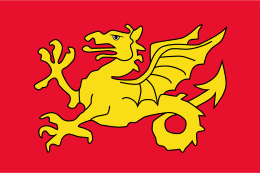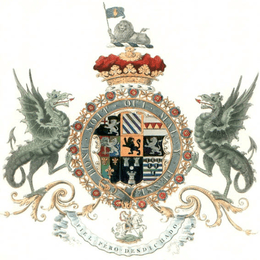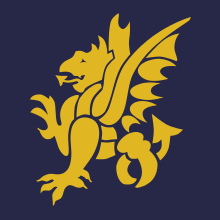Wyvern

A wyvern (/ˈwaɪvərn/ WY-vərn, sometimes spelled wivern) is a legendary creature with a dragon's head and wings, a reptilian body, two legs, and a tail. A sea-dwelling variant dubbed the sea-wyvern has a fish tail in place of a barbed dragon's tail.
The wyvern in its various forms is important to heraldry, frequently appearing as a mascot of schools and athletic teams (chiefly in the United States and United Kingdom). It is a popular creature in European and British literature, video games, and modern fantasy. The wyvern is often (but not always) associated with cold weather and ice, and it will sometimes possess a venomous bite and rarely have the ability to breathe fire.
Etymology
The usual spelling wyvern is not attested before the seventeenth century as "winged two-footed dragon".[1] It is an alteration of Middle English (attested thirteenth century) wyver, from Old French wivre (cf. French guivre and vouivre), itself from Latin vīpera, meaning 'viper', 'adder', 'asp'.[1][2]
History

The design of the wyvern to have derived from the figure of the dragon encountered by Trajan's legions in Dacia. It may be the origin of the red dragon of Wales and the golden dragon of the Kingdom of Wessex carried at the Battle of Burford in AD 752.[3]
Comparison to dragons
The wyvern has often been confused with the dragon, due to the similarities between them and due to the wyvern being a lesser-known mythical creature. In the Middle Ages, no clear distinction was made between the two. Since the sixteenth century, in English, Scottish, and Irish heraldry, the key distinction has been that a wyvern has two legs, whereas a dragon has four; however, this distinction is not generally observed in the heraldry of other European countries, where two-legged dragons are entirely acceptable.[4]
In modern fiction
In the modern fantasy genre, the wyvern is usually considered to have two legs, whereas the dragon may have either four or none. Wyverns tend to be smaller, weaker, not as intelligent, and ultimately inferior to the much more ferocious and powerful dragon. While a dragon almost always has the ability to breathe fire (though other types of breath such as lightning have been seen as well), a wyvern will usually be unable to breathe fire. Those that can breathe fire are sometimes termed "fire drakes" and are still considered a lesser form. A wyvern will typically be unable to speak, while a dragon often does have that ability.[5]
The wyvern features frequently in modern fantasy fiction, though its first literary appearances may have been in medieval bestiaries.[6] It appears in many works of fantasy fiction, such as Dungeons & Dragons, Throne of Glass by Sarah J. Maas, Final Fantasy, Magic: The Gathering, Dragon Age, Guild Wars 2 and World of Warcraft.
Fantasy film and gaming often features dragons which are wyvern-like in appearance (with two legs and two wings), as in Reign of Fire (both the film and the video game) or The Elder Scrolls V: Skyrim. In the How to Train Your Dragon franchise, Hookfang and Stormfly are both wyvern-like, while all the others are more traditional four-legged dragons.
In the manga series Lilim Kiss, by Mizuki Kawashita, one of the supporting characters, a high-school student "occult maniac" named Kojima, attempts to summon a lilim demon through a magical ritual, but actually conjures the wyvern that will later become Piyu-chan, a cute ball-like creature with bat wings, and rabbit ears.
In heraldry

The wyvern is a frequent charge in English heraldry and vexillology, also occasionally appearing as a supporter or crest.
A white (Argent) wyvern formed the crest of the Borough of Leicester as recorded at the heraldic visitation of Leicestershire in 1619: "A wyvern sans legs argent strewed with wounds gules, wings expanded ermine." The term "sans legs" may not imply that the wyvern was "without legs", rather that its legs are not depicted, being hidden or folded under.[7][8][9] This was adopted by the Midland Railway in 1845, when it became the crest of its unofficial coat of arms.[10] The company asserted that the "wyvern was the standard of the Kingdom of Mercia", and that it was "a quartering in the town arms of Leicester".[11][12][13][14] However, in 1897 the Railway Magazine noted that there appeared "to be no foundation that the wyvern was associated with the Kingdom of Mercia".[12]
A green Wyvern stands in the emblem of the ancient and historical umbrian city of Terni, the dragon is called by the citizens with the name of Thyrus. Sable wyvern on a white background with endorsed wings forms the coat of arms of the Tilley family.
The kings of Aragon of the House of Barcelona since Peter IV used a wyvern as a crest on their helmets. Nowadays this symbol has been officially adopted as the coat of arms of the Generalitat Valenciana (Valencian Parliament and Government).
The arms of the Worshipful Society of Apothecaries depict a wyvern, symbolising disease, being overcome by Apollo, symbolising medicine.
As a logo or mascot
The wyvern is also a fairly popular commercial logo or mascot, especially in Wales and what was once the West Country Kingdom of Wessex, but also farther afield in Herefordshire and Worcestershire, as the rivers Wye and Severn run through Hereford and Worcester respectively. For example, a local school travel company is called Wyvern Schooltours Ltd[15] and a local radio station was formerly called Wyvern FM. Vauxhall Motors had a model in its range in the 1950s called the Wyvern. The Westland Wyvern was a British single-seat carrier-based multi-role strike aircraft built by Westland Aircraft that served in the 1950s, seeing active service in the 1956 Suez Crisis.
The wyvern is a frequent mascot of athletic teams, colleges and universities, particularly in the United Kingdom and the United States, and is the mascot of the Korea Baseball Organization team SK Wyverns, established in 2000.
The wyvern is also the mascot of the 51st Operations Support Squadron at Osan Air Base, with the motto: "breathin' fire!"[16]
The wyvern is the mascot on the shirt of Leyton Orient F.C..
The wyvern is featured as the team mascot for Woodbridge College in Woodbridge, Ontario, Canada.
Examples
 Arms of Sophie, Countess of Wessex
Arms of Sophie, Countess of Wessex
 A carved wyvern on the choir stalls of Chester Cathedral in Cheshire, England, c. 1380
A carved wyvern on the choir stalls of Chester Cathedral in Cheshire, England, c. 1380 Arms of Midland Railway at Derby station, bearing in crest a wyvern sans legs
Arms of Midland Railway at Derby station, bearing in crest a wyvern sans legs Municipal arms of Stjørdal, Norway
Municipal arms of Stjørdal, Norway Municipal arms of Terni, Italy
Municipal arms of Terni, Italy 43rd (Wessex) Divisional insignia (World War II)
43rd (Wessex) Divisional insignia (World War II) Wyvern weather vane
Wyvern weather vane
See also
References
- 1 2 Hoad, T. F. (1993). English Etymology. Oxford: Oxford University Press. p. 546. ISBN 0-19-283098-8.
- ↑ "Oxford English Dictionary" (Second ed.). November 2010. Retrieved 2011-02-18.
- ↑ "Flags in the Bayeux Tapestry". Encyclopædia Romana.
- ↑ Dennys, Rodney (1975). The Heraldic Imagination. New York: Clarkson N. Potter. pp. 186–8. ISBN 0517526298.
- ↑ "Difference Between Wyvern and Dragon". DifferenceBetween.net. Retrieved 9 June 2015.
- ↑ A wyvern and an elephant may be found at Harley MS 3244 (dated 13th century, after c. 1236), f.39v.
- ↑ Geoffrey Briggs, Civic & Corporate Heraldry, London 1971
- ↑ C. W. Scot-Giles, Civic Heraldry of England and Wales, 2nd edition, London, 1953
- ↑ A. C. Fox-Davies, The Book of Public Arms, London 1915
- ↑ Cuthbert Hamilton Ellis, The Midland Railway, 1953
- ↑ Frederick Smeeton Williams, The Midland Railway: Its rise and progress: A narrative of modern enterprise, 1876
- 1 2 The Railway Magazine, Vol. 102, 1897
- ↑ Dow (1973)
- ↑ Clement Edwin Stretton, History of The Midland Railway, 1901
- ↑ "Welcome to Wyvern Schooltours".
- ↑ http://www.osan.af.mil/AboutUs/FactSheets/Display/tabid/4001/Article/641932/51st-operations-support-squadron.aspx
External links